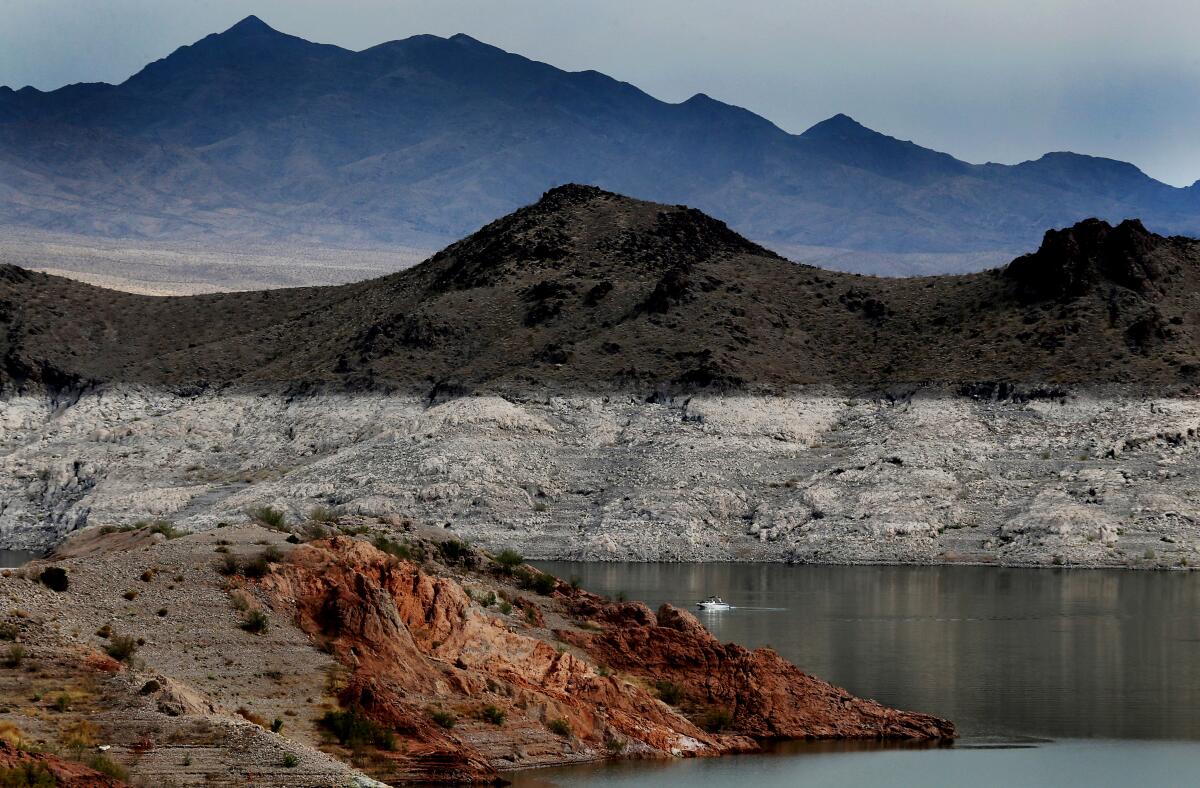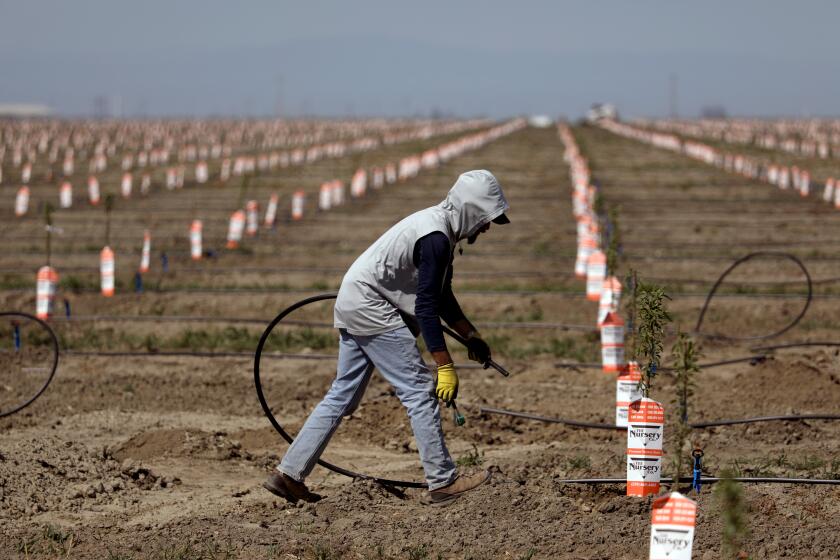California’s biggest heat wave of the year heightens drought and fire fears

- Share via
With a worsening drought gripping the West and wildfire season looming, California is bracing for the most severe heat wave of the year — one that promises to tax the state’s power supplies while also offering a grim preview of challenging months to come.
The heat wave will bring triple-digit temperatures to the valleys and inland regions of Southern California as well as many parts of the rest of the state, heightening fire risks. It comes as parts of Northern and Central California are turning to water restrictions as the drought rapidly alters the landscape.
In Lake Oroville over Memorial Day weekend, dozens of houseboats sat on cinder blocks because there wasn’t enough water to hold them. At Lake Mead, the largest reservoir in the United States, the water level dropped to about 1,072 feet Wednesday night — a low not seen since it was filled in the 1930s.
The Colorado River, where the reservoir is located, supplies water for 40 million people in Arizona, California, Colorado, Nevada, New Mexico, Utah and Wyoming. Officials said its water level could fall even farther.
The incoming heat wave can exacerbate that lack of moisture, experts said.
“With high temperatures, we’re going to get more evaporation and less water to use later on. We’re obviously not going to get much rain anytime soon,” said Mike Wofford, a meteorologist with the National Weather Service in Oxnard. “I’m not sure how much worse it makes it. It’s already pretty bad.”
The extreme temperatures are atypical in Los Angeles in June, which is usually still mired in a marine layer with clouds and fog, Woffard said.
The heat will be temporary, but the combination of intensely high temperatures and a prolonged dryness will worsen California’s critical climate condition.
“Early heat waves and more frequent heat waves this summer will exacerbate an already serious situation,” said climatologist Bill Patzert, noting that it is “way too early” in the year for such an event.
“It crosses many boundaries and really impacts everybody,” he said.
Lake Mead, a key reservoir on the Colorado River, is shrinking to record low levels, prompting concerns throughout the West about water supply.
The West has always been dry, but recent years have been some of the worst.
According to the Los Angeles Almanac, six of the last 10 years have had below-average rainfall. The parched span from 2011 to 2016 was the driest continuous five years ever recorded in downtown Los Angeles
Since Oct. 1, downtown L.A. has received a scant 5.8 inches of precipitation — about 41% of normal — putting it on track to be the eighth-driest in the 144 years since records have been kept.
The effects of the latest drought are already playing out across the region.
In the Bay Area this week, Santa Clara County officials declared a water shortage emergency, which could lead to mandatory water restrictions for the county’s 2 million residents. Marin County in May declared a drought emergency, not long after Gov. Gavin Newsom expanded his April 21 drought emergency across a vast swath of the state.
More than 40 of California’s 58 counties are now under a drought state of emergency.
And though dwindling water supplies can affect people at a local level, the results can resonate nationwide, particularly because California produces much of the country’s agriculture.
Already, many farmers in the Central Valley have declared the outlook for the year to be grim because of the drought, with some openly questioning their future in the state.
So far, Southern California’s water supply has not been hit as hard by the drought — but that may be temporary.
Jeffrey Kightlinger, general manager for the Metropolitan Water District of Southern California, said the region’s water supply comes primarily from the Colorado River and the Northern California Sierra Nevada range. Climate change is reducing the snowpack that feeds both.
“We know we’re going to get more droughts, and they’re going to be deeper and hotter, with less supply,” Kightlinger said. “We’re pretty well-prepared for the world of 2020, 2021, but that doesn’t mean we’re prepared for the world of 2030.”
As the San Joaquin Valley braces for yet another season of drought, some growers are openly questioning the future of farming here.
The imminent heat wave also will strain the energy grid as millions of residents crank up their air conditioners.
During a similar heat wave in August, the California Independent System Operator — the body that runs the electric grid for most of the state — declared a statewide Stage 3 emergency for the first time since 2001.
The agency on Friday issued a heat bulletin forecasting high electric demand.
“It is still too early to know the precise impact that next week’s high temperatures will have on the electric grid,” spokeswoman Anne Gonzales said. Flex alerts for energy conservation could be administered to prevent rolling blackouts.
Climate experts have also been sounding the alarm about how the combination of extreme heat and dryness can create bone-dry vegetation that acts as fuel for wildfires. Last year was the state’s worst wildfire season on record, and 2021 is already primed for another severe season.
What’s more, heat can make firefighting that much more difficult, so if blazes do ignite, fire crews will have to contend with dangerous conditions.
To help prevent wildfires from sparking during previous heat waves, the state’s utilities implemented preemptive power cuts known as public safety power shut-offs, or PSPS.
It’s too soon to know whether that will need to be done next week, Southern California Edison spokesperson David Song said, noting that shut-offs are typically driven by extreme wind events, not heat alone.
About 25% of the utility’s 50,000-square-mile coverage area is in a high-fire-risk zone, and residents in those areas would be notified 48 to 72 hours in advance of any outages, Song said.
Gov. Gavin Newsom has extended the emergency drought order to 41 counties — dramatically expanding his order from nearly three weeks ago.
Even California’s iconic beaches are under threat by the statewide desiccation, said USC research scientist Essam Heggy.
Sandy beaches are fed by sediment washed down from mountains. Without rain, shorelines begin to recede, something that is happening along the coast, said Heggy, who has spent the last 20 years researching deserts on Earth and other planets.
The California coastline has jumped about 60 feet inland in some places in the last 10 years, he said.
“All of the coastline — from San Diego to L.A. — is suffering massively from coastal erosion because of the drought,” Heggy said, adding that expensive beachfront homes also block sediment from reaching the shore.
Newport Beach and other wealthy seaside communities have had to haul in sand from elsewhere to replenish the erosion, Heggy said.
California has entered another drought. But depending on who you ask, the last one may have never really ended.
Heat waves are among the most dangerous of natural hazards, according to the World Health Organization. During a record-breaking spell last September, the deaths of at least three people in Los Angeles County were linked to heat exposure, the county coroner’s office determined.
Children, elderly residents and homeless people are among the most vulnerable when temperatures soar. Los Angeles has not yet announced whether it will open cooling centers next week.
But residents are advised to plan for ways to stay cool. Outdoor activities should be limited, especially in the afternoons, and pets and people should never be left alone in closed cars, the National Weather Service said.
Song said that peak electricity hours are from 4 to 9 p.m. and recommended that residents pre-cool their homes and avoid using high-energy appliances during that time.
According to Wofford, the incoming heat wave is being driven by both a high-pressure ridge building from the Southeast and a weakening onshore air flow, which is what brings June’s more-typical cooling sea breeze.
But, Patzert said, it’s all part of the same human-driven trend toward global warming.
“It’s unusually early, it’s unusually large and it’s unusually long,” he said of the extended heat, “but it’s consistent with what we see, over the past couple of decades, that we relate to climate change.”
There have been significant periods of heat and dryness in the past, he said, including a long drought from 1945 to 1978, but the fundamental difference between then and now is the state’s size: California’s population has quadrupled since the 1950s, putting more strain on its electric grid, agricultural output and limited water supply.
Heat waves are getting longer, more intense and more frequent, Patzert said — and there’s no sign they will get any better.
“We’re living in a warmer California and drier California,” he said.
More to Read
Sign up for Essential California
The most important California stories and recommendations in your inbox every morning.
You may occasionally receive promotional content from the Los Angeles Times.



















